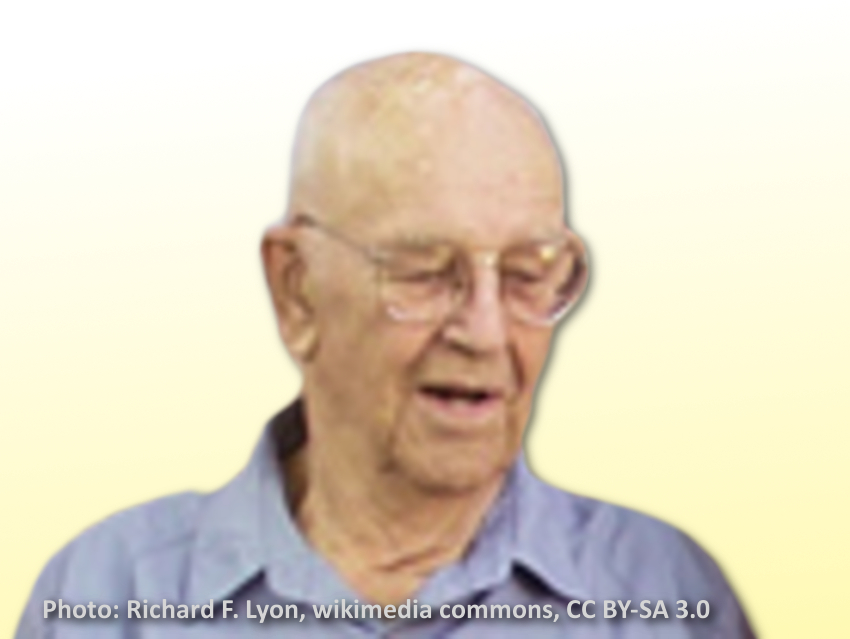Larned B. Asprey was born on March 19, 1919, in Sioux City, IA, USA. He was a pioneer of actinide and fluoride chemistry.
Asprey studied chemistry at Iowa State University, where he obtained a Bachelor of Science degree in 1940. In 1941, during World War II, Asprey was drafted into the Army. He was assigned to work under Glenn T. Seaborg at the Metallurgical Laboratory in Chicago. The team was part of the Manhattan Project and worked on the separation and purification of plutonium. Asprey’s work there, together with Herbert H. Anderson, provided the basis for the PUREX process (plutonium uranium redox extraction), which is still used to recover uranium and plutonium. In 1945, Asprey co-signed the “Szilard Petition”, drafted by Manhattan Project worker Leo Szilard, which asked the U.S. President not to use atomic bombs against Japan.
Asprey received his Ph.D. from the University of California, Berkeley, USA, in 1949 under the supervision of B. B. Cunningham for work on actinide and lanthanide oxides. The same year, he joined the Los Alamos Scientific Laboratory, NM, USA (renamed Los Alamos National Laboratory in 1981). There, he continued to work on actinides, e.g., on the isolation and chemistry of americium. He also made important contributions to the understanding of the chemistry of other actinides and lanthanides.
Asprey’s work on high oxidation states of the actinides and lanthanides often involved the use of fluorine. This led him to become an authority on fluorine chemistry. He discovered a process for the preparation of extremely pure fluorine gas and was involved in the synthesis of many volatile fluorides. In his later career, he worked on the preparation of the “superoxidizers” dioxygen difluoride (O2F2) and krypton difluoride (KrF2), which were used in plutonium research. Larned “Larry” B. Asprey retired from Los Alamos National Laboratory in 1986. He died on March 6, 2005, in Mesilla Park, NM, USA.
Larned B. Asprey is the answer to Guess the Chemist (87).
Sources
- Pioneer actinide chemist Larned Asprey dies,
P. Gary Eller, Bob Penneman, Bob Ryan,
Actinide Research Quarterly, Los Alamos National Lab, 2005.
https://www.lanl.gov (accessed February 2019) - Larned B. Asprey,
Atomic Heritage Foundation.
https://www.atomicheritage.org/profile/larned-b-asprey (accessed February 2019)
Selected Publications
- Vibrational Spectra and Force Constants for Nitrosyl Fluoride and 15N and 18O Species,
Llewellyn H. Jones, Larned B. Asprey, Robert R. Ryan,
J. Chem. Phys. 1967, 47, 3371–3376.
https://doi.org/10.1063/1.1712402 - Vibrational Spectra and Force Constants for Isotopic Species of Nitrosyl Chloride,
Llewellyn H. Jones, Robert R. Ryan, Larned B. Asprey,
J. Chem. Phys. 1968, 49, 581–585.
https://doi.org/10.1063/1.1670112 - Crystal structure of potassium pentafluorotellurate (KTeF5),
S. H. Mastin, R. R. Ryan, L. B. Asprey,
Inorg. Chem. 1970, 9, 2100–2103.
https://doi.org/10.1021/ic50091a028 - Vibrational spectrum and force field of uranium hexafluoride,
Robin S. McDowell, Larned B. Asprey, Robert T. Paine,
J. Chem. Phys. 1974, 61, 3571–3580.
https://doi.org/10.1063/1.1682537 - Electronic and vibronic states of uranium hexafluoride in the gas and in the solid phase at very low temperatures,
W. B. Lewis, L. B. Asprey, L. H. Jones, R. S. McDowell, S. W. Rabideau, A. H. Zeltmann, R. T. Paine,
J. Chem. Phys. 1976, 65, 2707–2714.
https://doi.org/10.1063/1.433414 - The preparation of very pure fluorine gas,
Larned B. Asprey,
J. Fluorine Chem. 1976, 7, 359–361.
https://doi.org/10.1016/S0022-1139(00)84009-9 - Preparation and Purification of Actinide Metals,
J. C. Spirlet, J. R. Peterson, L. B. Asprey,
Adv. Inorg. Chem. 1987, 31, 1–41.
https://doi.org/10.1016/S0898-8838(08)60220-2 - Analytical applications of superacid dissolution of actinide and lanthanide substrates,
L. R. Avens, P. G. Eller, L. B. Asprey, K. D. Abney, S. A. Kinkead,
J. Radioanal. Nucl. Chem. 1988, 123, 707–712.
https://doi.org/10.1007/bf02034929 - Reactions of dioxygen difluoride with neptunium oxides and fluorides,
P. Gary Eller, Larned B. Asprey, Scott A. Kinke, Basil I. Swanson, Richard J. Kissane,
J. Alloys Compd. 1998, 269, 63–66.
https://doi.org/10.1016/S0925-8388(98)00005-X
Also of Interest
- 75th Anniversary: Discovery of Plutonium,
ChemViews Mag. 2015.
Element 94 was first produced and isolated at the Berkeley Radiation Laboratory in 1940
(includes a short biography of Glenn T. Seaborg)



